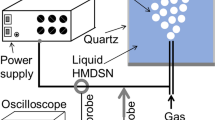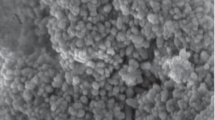Abstract
Synthesis of aluminium-containing nanoparticles (NPs) by electrical discharges was performed in three dielectric liquids (heptane, liquid nitrogen and water) with aluminium electrodes. The nature of the liquid plays an essential role in the synthesis yield and in the structural properties of NPs. Time-resolved optical emission spectroscopy of selected emission lines emitted during the discharge and its time afterglow was used to observe the chemical changes occurring in the gas phase. It turns out that in heptane and liquid nitrogen, crystalline metallic NPs (from 5 to 10 nm in diameter) are synthesized and oxidized next into amorphous alumina when they are in contact with air, once the liquid is evaporated. In heptane, the transformation of the liquid itself into hydrogenated amorphous carbon creates a kind a matrix in which the aluminium NPs are embedded. Sometimes, a protective graphite shell grows around the NPs and protects them from any further oxidation. In water, these crystalline metallic NPs are synthesized during the first 800 ns of the discharge process, when oxidation is limited by the outward flux of the metallic vapour. They are oxidized next in water. A second type of alumina NPs (several 10 s of nm in diameter) are produced from 800 ns on. They are likely formed from AlO molecules and no longer from aluminium atoms. In every liquid, sub-micrometric particles are also found due to droplet emission from the liquid well created during impacts of spark discharges on electrodes.











Similar content being viewed by others
References
Ostrikov K, Neyts EC, Meyyappan M (2013) Plasma nanoscience: from nano-solids in plasmas to nano-plasmas in solids. Adv Phys 62:113–224
Ostrikov K (2011) Control of energy and matter at nanoscales: challenges and opportunities for plasma nanoscience in a sustainability age. J Phys D Appl Phys 44:174003
Graham W, Stalder K (2011) Plasmas in liquids and some of their applications in nanoscience. J Phys D Appl Phys 44:174037
Chiang W-H, Sankaran RM (2007) Microplasma synthesis of metal nanoparticles for gas-phase studies of catalyzed carbon nanotube growth. Appl Phys Lett 91:121503
Mariotti D, Sankaran RM (2011) Perspectives on atmospheric-pressure plasmas for nanofabrication. J Phys D Appl Phys 44:174023
Mariotti D, Patel J, Švrček V, Maguire P (2012) Plasma–liquid interactions at atmospheric pressure for nanomaterials synthesis and surface engineering. Plasma Process Polym 9:1074–1085
Sano N, Wang H, Alexandrou I, Chhowalla M, Teo KBK, Amaratunga GAJ, Iimura K (2002) Properties of carbon onions produced by an arc discharge in water. J Appl Phys 92:2783–2788
Hamdan A, Noël C, Ghanbaja J, Migot-Choux S, Belmonte T (2013) Synthesis of platinum embedded in amorphous carbon by micro-gap discharge in heptane. Mater Chem Phys 142:199–206
Lo CH, Tsung TT, Chen LC, Su CH, Lin HM (2005) Fabrication of copper oxide nanofluid using submerged arc nanoparticle synthesis system (SANSS). J Nanopart Res 7:313–320
Lo CH, Tsung TT, Lin HM (2007) Preparation of silver nanofluid by the submerged arc nanoparticle synthesis system (SANSS). J Alloys Comp 434:659–662
Hamdan A, Kosior F, Noel C, Henrion G, Audinot JN, Gries T, Belmonte T (2013) Plasma-surface interaction in heptane. J Appl Phys 113:213303
Belmonte T, Hamdan A, Kosior F, Noël C, Henrion G (2014) Interaction of discharges with electrode surfaces in dielectric liquids: application to nanoparticle synthesis. J Phys D Appl Phys 47:224016
Schoenbach K, Kolb J, Xiao S, Katsuki S, Minamitani Y, Joshi R (2008) Electrical breakdown of water in microgaps. Plasma Sources Sci Technol 17:024010
Sano N, Kawanami O, Charinpanitkul T, Tanthapanichakoon W (2008) Study on reaction field in arc-in-water to produce carbon nano-materials. Thin Solid Films 516:6694–6698
Hamdan A, Audinot J-N, Noel C, Kosior F, Henrion G, Belmonte T (2013) Interaction of micro-discharges in heptane with metallic multi-layers. Appl Surf Sci 274:378–391
Bouchet D, Colliex C (2003) Experimental study of ELNES at grain boundaries in alumina: intergranular radiation damage effects on Al-L23 and O-K edges. Ultramicroscopy 96:139–152
Fehlner FP, Mott NF (1970) Low-temperature oxidation. Oxid Met 2:59–99
Hamdan A, Marinov I, Rousseau A, Belmonte T (2014) Time-resolved imaging of nanosecond-pulsed micro-discharges in heptane. J Phys D Appl Phys 47:055203
Tortai JH, Bonifaci N, Denat A, Trassy C (2005) Diagnostic of the self-healing of metallized polypropylene film by modeling of the broadening emission lines of aluminum emitted by plasma discharge. J Appl Phys 97:053304
Sakka T, Nakajima T, Ogata YH (2002) Spatial population distribution of laser ablation species determined by self-reversed emission line profile. J Appl Phys 92:2296–2303
Descoeudres A, Hollenstein C, Demellayer R, Wälder G (2004) Optical emission spectroscopy of electrical discharge machining plasma. J Mater Process Technol 149:184–190
Author information
Authors and Affiliations
Corresponding author
Electronic supplementary material
Below is the link to the electronic supplementary material.
11090_2014_9564_MOESM1_ESM.docx
EEL spectra corresponding to the Al-L2,3 edge showing the crystallization process of medium-sized particles made of amorphous alumina particles into γ-alumina under the electron beam. Micrographs of the medium-sized particle studied here before and after irradiance are provided together with their corresponding selected area electron diffraction (SAED) patterns. Synthesis in water. (DOCX 251 kb)
11090_2014_9564_MOESM3_ESM.docx
Rotational temperatures of AlO (blue-green system) as a function of time. Insert: comparison between an experimental spectrum and its simulated spectrum. (DOCX 170 kb)
Rights and permissions
About this article
Cite this article
Hamdan, A., Noël, C., Ghanbaja, J. et al. Comparison of Aluminium Nanostructures Created by Discharges in Various Dielectric Liquids. Plasma Chem Plasma Process 34, 1101–1114 (2014). https://doi.org/10.1007/s11090-014-9564-y
Received:
Accepted:
Published:
Issue Date:
DOI: https://doi.org/10.1007/s11090-014-9564-y




